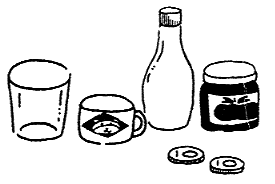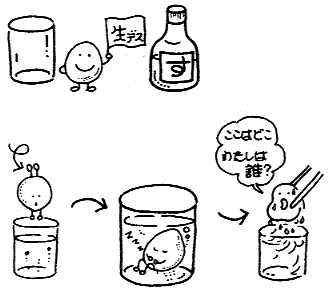
Internet Version [Naruhodo no Mori] Vol. 4
by Yumiko Mori

Vol. 4 July 15th, 1995
Just dipping
Home science experiments for mothers of elementary school children
Toshi brings ketchup and Worcestershire sauce from the kitchen.
Tae: "Toshi, are you going to cook something nice today?"
Toshi: "No, I am not. These sauces are for the experiment."
Tae: "Can we eat after the experiment?"
Toshi: "You are thinking about only eating."
Tae: "I'm so hungry!"
Toshi: "This is a very easy experiment.
You put either ketchup or source in a cup.
Then you just dip 10 yen coins"
Tae: "What's going to happen to the 10 yen coins?"
Toshi: " It'll be cleaned. You'll see."
Tae: "It sounds very interesting."
20 minutes later,
Tae: "Toshi, 10 yen coins are getting pink a little bit."
Toshi: "Let's wait for a while. It's still early."
20 minutes later,
Toshi: "Let's pick the coins up and wash them!"
Tae: "Oh, it's totally pink!"
Toshi: "What happened to coins in the source?"
Tae: "Yes! They also become pink."
Toshi: "Shall we repeat this with soy source?"
Tae: "I'll help you. How about detergent?
We can also try salt water or sugar water."
Toshi: "We'll need a lot of 10 yen coins."
Tae: "Why? My coins didn't turn to pink! But yours are all pink.
That's not fair!"
Toshi: "I am sorry."
Tae: "By the way, I am very hungry."
Toshi: "I've got an idea.
How about taking these pink coins and buying candy?"
Tae: "Can we use these pink coins?"
Toshi: "Yes, of course!
This pink color is their original color."
Tae: "I didn't know that. Let's go!"
Dipping Experiment #1
Requited time: 1 hour, A very easy experiment!

Materials
- Several cups
- Several cupper coins (Not silver coins)
- Ketchup, soy source, Worcestershire sauce, steak source, and others you want to test
Method
- Place each source into different cups.
- Put a coin into each cup and check what will happen to coins.
**** Reason why coins become pink ****
The surface of copper coins is constantly exposed to air,
and therefore the copper turns into oxidized form (CuO).
Amino acids or sugar molecules in catsup or Worcestershire source reduce
(reverse reaction to oxidization) the copper oxide into copper.
Then it recovers its original copper color.
Judged from my results, soy source and Tabasco (chili source) appear to work best.
As an alternative method, you could hold a coin with a pair of pliers,
heat up the coin in burning flame, and then dip the coin into liquor.
Dipping experiment #2
--- Melting egg shell ---

Required time: It'll take about 3 days.
Materials
- A glass cup
- A raw egg
- Vinegar
Methods
- Put the egg into the cup carefully not to break the shell.
- Pour the vinegar into the cup up to the top of the egg.
- If you see bubbles around the egg, stir the vinegar gently with a chop stick or a stirrer.
- Observe the egg for three days. You may touch it.
- When the entire shell gets melted and the egg becomes like a rubber ball,
you can take the egg out from the cup.
The egg shell is mainly made of calcium carbonate.
Calcium carbonate reacts with acid, producing calcium and carbon dioxide.
Therefore the bubbles you see around the egg are those of carbon dioxide.
See shells can be also melted by the same method.
Enjoy something unexpected
I am neither a scientist nor a school teacher. I am just a mother of three children.
I've never thought about dipping coins into ketchup before.
I am surprized at the unexpected combination.
I couldn't imagine ketchup is put on something other than food.
After I finished this experiment, I felt as if my brain became more flexible.
Why don't your family try too?
| Author | Yumiko Mori (Zushi, Kanagawa, Japan) |
|---|
| Illustration | Mitsue Ogata |
|---|
| Translator | Akira Ishihara |
|---|
| HTML format | Muneo Kume |
|---|
Copyright © 1995 Rika no Heya & Yumiko Mori








